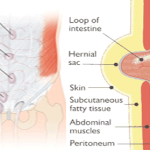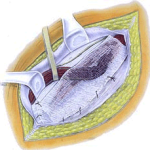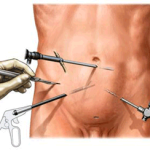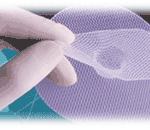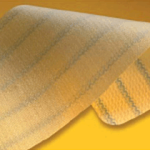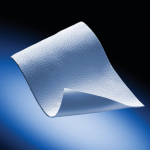PATIENT INFORMATION FOR LAPAROSCOPIC REPAIR OF HERNIA [INGUINAL/FEMORAL/UMBILICAL/EPIGASTRIC/INCISIONAL]
- WHAT IS A HERNIA?
- HOW DO I KNOW IF I HAVE A HERNIA?
- WHAT CAUSES A HERNIA?
- HOW IS HERNIA TREATED?
- WHAT IS A MESH?
- WHAT SHOULD I EXPECT AFTER SURGERY?
- IS IT RISKY FOR PEOPLE WITH OTHER MEDICAL PROBLEMS LIKE DIABETES, HYPERTENSION & MORBID OBESITY?
- WHAT ARE THE OTHER PROCEDURES THAT CAN BE DONE LAPAROSCOPICALLY?
- A hernia occurs when the inside layers of the abdominal muscle have weakened, resulting in a bulge or tear. In the same way that an inner tube pushes through a damaged tire, the inner lining of the abdomen pushes through the weakened area of the abdominal wall to form a small balloon-like sac.
- Both men and women can get a hernia.
- You may be born with a hernia (congenital) or develop one over time.
- A hernia does not get better over time, nor will it go away by itself.
- The common areas where hernias occur are in the groin (inguinal), belly button (umbilical), and the site of a previous operation (incisional).
- You may notice a bulge under the skin. You may feel pain when you lift heavy objects, cough, strain during urination or daefecation, or during prolonged standing or sitting.
- Severe, continuous pain, redness, and tenderness are signs that the hernia may be entrapped or strangulated. These symptoms are cause of concern and warrant immediate contact with your physician or surgeon.
- Bulge may disappear on lying down.
The wall of the abdomen has natural areas of potential weakness. Hernias can develop at these or other areas due to heavy strain on the abdominal wall, ageing, injury, an old incision or a weakness present from birth. Anyone can develop a hernia at any age. Most hernias in children are congenital. In adults, a natural weakness or strain from heavy lifting, persistent coughing, difficulty with bowel movements or urination can cause the abdominal wall to weaken or separate.
TYPES OF HERNIA
- Inguinal hernia – as shown in Fig 1
- Femoral Hernia – as shown in Fig 1
Other Hernias
1. Incisional–It arises in the abdominal wall where a previous surgical incision was made In this area the abdominal muscles have weakened; this results in a bulge or a tear. This can allow a loop of intestines or other abdominal contents to push into the sac. Incisional hernias occur in people who have had previous abdominal surgery, and are more likely to occur in people who are obese or pregnant .Incisional hernias are caused by thinning or stretching of scar tissue that forms after surgery. This weakened scar tissue then creates a weakness in the abdominal wall.
2. Umbilical– An umbilical hernia is a condition in which a defect or hole exists in the abdominal wall at the level of the umbilicus (belly button). It commonly is found in neonates (babies). Shown in Fig 1
3. Epigastric-An epigastric hernia is a hernia in the epigastric region of a human. Typically there is a small defect of the linea alba between the rectus abdominis muscles. This allows tissue from inside the abdomen to herniate anteriorly. (Shown in Fig 1 )
- Hernias usually need to be surgically repaired to prevent intestinal damage and further complications.
- Use of a truss {hernia belt} is usually ineffective.
- Surgical procedures are done in one of the two fashions:-Your surgeon will determine the best method of repair for individual situation:-
- The open approach is done from the outside through a three or four inch long incision in the groin. The surgeon may choose to use a small piece of surgical mesh to repair the defect.
The laparoscopic hernia repair. In this approach, a laparoscope (a tiny telescope) connected to a special camera is inserted through a trocar, a small hollow tube, allowing the surgeon to view the hernia and surrounding tissue on a video screen. Other trocars are inserted which allow your surgeon to work “inside.” Three or four quarter inch incisions are usually necessary. The hernia is repaired from behind the abdominal wall. A small piece of surgical mesh is placed over the hernia defect and held in place with small surgical staples. This operation is usually performed with general anesthesia or occasionally using regional or spinal anesthesia .
ARE YOU A CANDIDATE FOR LAPAROSCOPIC HERNIA REPAIR?
Only after a thorough examination can your surgeon determine whether laparoscopic hernia repair is right for you. The procedure may not be best for some patients who have had previous abdominal surgery or underlying severe medical conditions.
- MESH Surgical material, made from synthetic plastic (i.e: Polypropylene) or gortex) or even biodegradable substances, used to repair hernias. These sterile mesh “SCREENS”, or “PATCHES” are soft, pliable, flexible, and ‘wafer – thin’ so as to conform to body movement and size. Yet they are remarkably strong to immediately add strength and fully repair the hernia while allowing rapid resumption of “Normal” activities, including SPORTS. Many varieties, shapes and sizes of Mesh Systems are available. Hernias differ from patient to patient, and we firmly believe that any given single mesh system or manufacturer is not appropriate for effective repair of all hernias. We therefore evaluate the anatomic and physical properties of each hernia at the time of surgery, then use our expertise to select the appropriate mesh form and TENSION FREE TECHNIQUE to satisfactorily repair your hernia defect appropriately.
WHAT SHOULD I EXPECT AFTER SURGERY?
- Following the operation, you will be transferred to the recovery room where you will be monitored for 1-2 hours until you are fully awake.
- With any hernia operation, you can expect some soreness mostly during the first 24 to 48 hours.
- You are encouraged to be up and about the day after surgery.
- With laparoscopic hernia repair, you will probably be able to get back to your normal activities within a few days. These activities include showering, driving, climbing stairs, lifting, working and engaging in sexual intercourse.
- A follow-up appointment within a week after your operation is scheduled.
- Strenuous activity and exercise are restricted for 2 to 4 weeks after surgery.
IS IT RISKY FOR PEOPLE WITH OTHER MEDICAL PROBLEMS LIKE DIABETES, HYPERTENSION & MORBID OBESITY?
- Not at all. On the contrary, absence of major trauma to the body causes minimal disturbance of normal physiology. Hence, there is no risk of aggravation of other conditions.
WHAT ARE THE OTHER PROCEDURES THAT CAN BE DONE LAPAROSCOPICALLY?
Almost every organ in the human body has become accessible to the surgeon and MAS can be applied to most of the surgical procedures. Some of the conditions for which Minimally Access Surgeries are commonly performed are:-
- Abdomen – Gall bladder stones, Appendicitis, Gastro – intestinal ulcers, Colorectal Surgeries, Splenectomy.
- Hernias – Inguinal, Umbilical, Epigastric, Femoral& Incisional.
- Urinary System- Urinary stones, Enlarged prostate, Kidney & Bladder tumors.
- Bones & joints
- Chest – VATS for empyema, decortication and Sympathectomy.
![<h1 align="center"><strong>PATIENT INFORMATION FOR LAPAROSCOPIC REPAIR OF HERNIA [INGUINAL/FEMORAL/UMBILICAL/EPIGASTRIC/INCISIONAL]</strong></h1> <ul> <li><strong><a href="#1">WHAT IS A HERNIA?</a></strong></li> <li><strong><a href="#2">HOW DO I KNOW IF I HAVE A HERNIA?</a></strong></li> <li><strong><a href="#3">WHAT CAUSES A HERNIA?</a></strong></li> <li><strong><a href="#4">HOW IS HERNIA TREATED?</a></strong><a href="#4"> </a></li> <li><strong><a href="#5">WHAT IS A MESH?</a></strong></li> <li><strong><a href="#6">WHAT SHOULD I EXPECT AFTER SURGERY?</a></strong></li> <li><strong><a href="#7">IS IT RISKY FOR PEOPLE WITH OTHER MEDICAL PROBLEMS LIKE DIABETES, HYPERTENSION & MORBID OBESITY?</a></strong></li> <li><strong><a href="#8">WHAT ARE THE OTHER PROCEDURES THAT CAN BE DONE LAPAROSCOPICALLY?</a></strong></li> </ul> <p><strong><a name="1" id="1"></a>WHAT IS A HERNIA?</strong></p> <ul type="disc"> <li>A hernia occurs when the inside layers of the abdominal muscle have weakened, resulting in a bulge or tear. In the same way that an inner tube pushes through a damaged tire, the inner lining of the abdomen pushes through the weakened area of the abdominal wall to form a small balloon-like sac.<strong> </strong></li> <li>Both men and women can get a hernia. </li> <li>You may be born with a hernia (congenital) or develop one over time. </li> <li>A hernia does not get better over time, nor will it go away by itself.</li> </ul> <p><strong><a name="2" id="2"></a>HOW DO I KNOW IF I HAVE A HERNIA?</strong></p> <ul> <li>The common areas where hernias occur are in the groin (inguinal), belly button (umbilical), and the site of a previous operation (incisional). </li> </ul> <ul type="disc"> <li>You may notice a bulge under the skin. You may feel pain when you lift heavy objects, cough, strain during urination or <strong><u>daefecation</u></strong>, or during prolonged standing or sitting.</li> <li>Severe, continuous pain, redness, and tenderness are signs that the hernia may be entrapped or strangulated. These symptoms are cause <strong><u>of</u></strong> concern and <strong><u>warrant </u></strong>immediate contact <strong><u>with</u></strong> your physician or surgeon. </li> <li>Bulge may disappear on lying down.</li> </ul> <p><a name="3" id="3"></a><strong>WHAT CAUSES A HERNIA?</strong> <br /> The wall of the abdomen has natural areas of potential weakness. Hernias can develop at these or other areas due to heavy strain on the abdominal wall, ageing, injury, an old incision or a weakness present from birth. Anyone can develop a hernia at any age. Most hernias in children are congenital. In adults, a natural weakness or strain from heavy lifting, persistent coughing, difficulty with bowel movements or urination can cause the abdominal wall to weaken or separate.</p> <p><strong>TYPES OF HERNIA</strong></p> <ul type="square"> <li><strong>Inguinal hernia - </strong>as shown in Fig 1<strong> </strong></li> </ul> <ul type="square"> <li><strong>Femoral Hernia - </strong>as shown in Fig 1<strong> </strong><br /> </li> </ul> <p><strong>Other Hernias <br /> 1. <u>Incisional</u></strong><u>-</u>It arises in the abdominal wall where a previous surgical incision was made In this area the abdominal muscles have weakened; this results in a bulge or a tear. This can allow a loop of intestines or other abdominal contents to push into the sac. Incisional hernias occur in people who have had previous abdominal surgery, and are more likely to occur in people who are obese or pregnant .Incisional hernias are caused by thinning or stretching of scar tissue that forms after surgery. This weakened scar tissue then creates a weakness in the abdominal wall. <br /> 2. <strong>U<u>mbilical</u></strong><u>-</u> An umbilical hernia is a condition in which a defect or hole exists in the abdominal wall at the level of the umbilicus (belly button). It commonly is found in neonates (babies). <em>Shown in Fig 1</em><strong> </strong><br /> <strong>3. <u>Epigastric</u></strong>-An epigastric hernia is a <a href="http://en.wikipedia.org/wiki/Hernia" title="Hernia">hernia</a> in the epigastric region of a human. Typically there is a small defect of the <a href="http://en.wikipedia.org/wiki/Linea_alba" title="Linea alba">linea alba</a> between the <a href="http://en.wikipedia.org/wiki/Rectus_abdominis" title="Rectus abdominis">rectus abdominis</a> muscles. This allows tissue from inside the abdomen to herniate anteriorly. (Shown in Fig 1 )<strong> </strong><br /> </p> <p><strong><a name="4" id="4"></a>HOW IS HERNIA TREATED?</strong><strong> </strong></p> <ul type="disc"> <li>Hernias usually need to be surgically repaired to prevent intestinal damage and further complications.</li> <li>Use of a truss {hernia belt} is usually ineffective.</li> <li>Surgical procedures are done in one of the two fashions:-Your surgeon will determine the best method of repair for individual situation:-</li> <ul type="square"> <li> <strong><u>The open approach</u></strong> is done from the outside through a three or four inch long incision in the groin. The surgeon may choose to use a small piece of surgical mesh to repair the defect.<strong></strong></li> </ul> </ul> <p><strong><u>The laparoscopic hernia repair</u></strong>. In this approach, a laparoscope (a tiny telescope) connected to a special camera is inserted through a trocar, a small hollow tube, allowing the surgeon to view the hernia and surrounding tissue on a video screen. Other trocars are inserted which allow your surgeon to work "inside." Three or four quarter inch incisions are usually necessary. The hernia is repaired from behind the abdominal wall. A small piece of surgical mesh is placed over the hernia defect and held in place with small surgical staples. This operation is usually performed with general anesthesia or occasionally using regional or spinal anesthesia </p> <p><strong>ARE YOU A CANDIDATE FOR LAPAROSCOPIC HERNIA REPAIR?</strong> <br /> Only after a thorough examination can your surgeon determine whether laparoscopic hernia repair is right for you. The procedure may not be best for some patients who have had previous abdominal surgery or underlying severe medical conditions.<br /> </p> <p><strong><a name="5" id="5"></a>WHAT IS A MESH?</strong> </p> <ul type="disc"> <li><em><u>MESH</u></em> Surgical material, made from synthetic plastic (i.e: <a href="http://www.hernia.com/mesh_def.html" target="_blank">Polypropylene</a>) or gortex) or even biodegradable substances, used to repair hernias. These sterile mesh "SCREENS", or "PATCHES" are soft, pliable, flexible, and 'wafer - thin' so as to conform to body movement and size. Yet they are remarkably strong to immediately add strength and fully repair the hernia while allowing rapid resumption of "Normal" activities, including <a href="http://hernia.tripod.com/faqs.html#k" target="_blank">SPORTS</a>. Many varieties, shapes and sizes of <a href="http://members.tripod.com/~hernia/meshsyst.html" target="_blank">Mesh Systems</a> are available. Hernias differ from patient to patient, and we firmly believe that any given single mesh system or manufacturer is not appropriate for effective repair of all hernias. We therefore evaluate the anatomic and physical properties of each hernia at the time of surgery, then use our expertise to select the appropriate mesh form and <a href="http://hernia.tripod.com/vocab2.html#TENS#TENS" target="_blank">TENSION FREE TECHNIQUE</a> to satisfactorily repair your hernia defect appropriately. </li> </ul> <p><strong><a name="6" id="6"></a>WHAT SHOULD I EXPECT AFTER SURGERY?</strong> </p> <ul type="disc"> <li>Following the operation, you will be transferred to the recovery room where you will be monitored for 1-2 hours until you are fully awake. </li> <li>With any hernia operation, you can expect some soreness mostly during the first 24 to 48 hours. </li> <li>You are encouraged to be up and about the day after surgery. </li> <li>With laparoscopic hernia repair, you will probably be able to get back to your normal activities within a few days. These activities include showering, driving, climbing stairs, lifting, working and engaging in sexual intercourse. </li> <li>A follow-up appointment within a week after your operation is scheduled. </li> <li>Strenuous activity and exercise are restricted for 2 to 4 weeks after surgery.</li> </ul> <p><strong><a name="7" id="7"></a>IS IT RISKY FOR PEOPLE WITH OTHER MEDICAL PROBLEMS LIKE DIABETES, HYPERTENSION & MORBID OBESITY?</strong></p> <ul type="disc"> <li>Not at all. On the contrary, absence of major trauma to the body causes minimal disturbance of normal physiology. Hence, there is no risk of aggravation of other conditions.</li> </ul> <p><strong><a name="8" id="8"></a>WHAT ARE THE OTHER PROCEDURES THAT CAN BE DONE LAPAROSCOPICALLY?</strong><br /> Almost every organ in the human body has become accessible to the surgeon and MAS can be applied to most of the surgical procedures. Some of the conditions for which Minimally Access Surgeries are commonly performed are:-</p> <ul type="disc"> <li>Abdomen - Gall bladder stones, Appendicitis, Gastro – intestinal ulcers, Colorectal Surgeries, Splenectomy.<strong></strong></li> <li>Hernias – Inguinal, Umbilical, Epigastric, Femoral& Incisional.<strong></strong></li> <li>Urinary System- Urinary stones, Enlarged prostate, Kidney & Bladder tumors.<strong></strong></li> <li>Bones & joints </li> <li>Chest – VATS for empyema, decortication and Sympathectomy. </li> </ul>](http://www.drsudhirkalhan.com/wp-content/uploads/2014/04/hernia-01-150x150.png)
